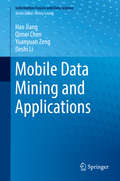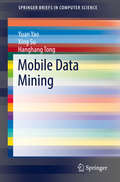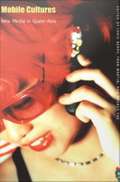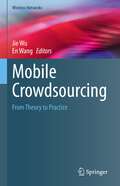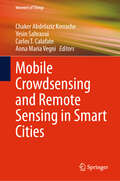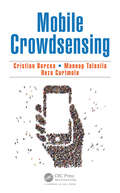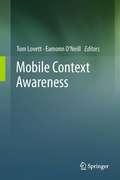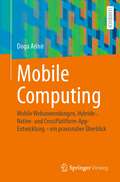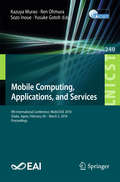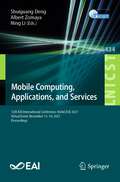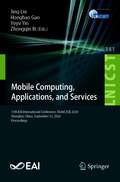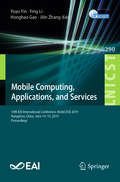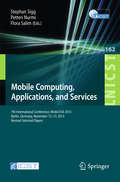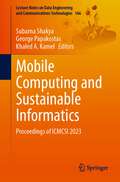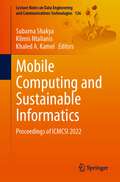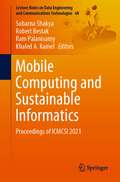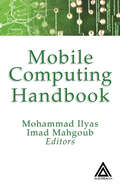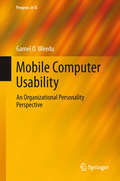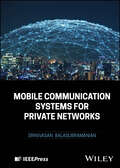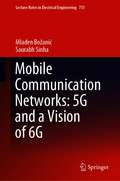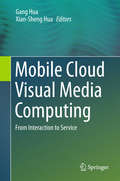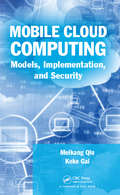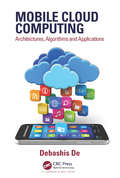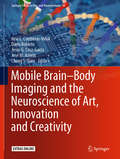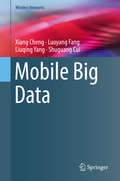- Table View
- List View
Mobile Data Mining and Applications (Information Fusion and Data Science)
by Hao Jiang Qimei Chen Yuanyuan Zeng Deshi LiThis book focuses on mobile data and its applications in the wireless networks of the future. Several topics form the basis of discussion, from a mobile data mining platform for collecting mobile data, to mobile data processing, and mobile feature discovery. Usage of mobile data mining is addressed in the context of three applications: wireless communication optimization, applications of mobile data mining on the cellular networks of the future, and how mobile data shapes future cities. In the discussion of wireless communication optimization, both licensed and unlicensed spectra are exploited. Advanced topics include mobile offloading, resource sharing, user association, network selection and network coexistence. Mathematical tools, such as traditional convexappl/non-convex, stochastic processing and game theory are used to find objective solutions. Discussion of the applications of mobile data mining to cellular networks of the future includes topics such as green communication networks, 5G networks, and studies of the problems of cell zooming, power control, sleep/wake, and energy saving. The discussion of mobile data mining in the context of smart cities of the future covers applications in urban planning and environmental monitoring: the technologies of deep learning, neural networks, complex networks, and network embedded data mining. Mobile Data Mining and Applications will be of interest to wireless operators, companies, governments as well as interested end users.
Mobile Data Mining (SpringerBriefs in Computer Science)
by Yuan Yao Xing Su Hanghang TongThis SpringerBrief presents a typical life-cycle of mobile data mining applications, including:data capturing and processing which determines what data to collect, how to collect these data, and how to reduce the noise in the data based on smartphone sensors feature engineering which extracts and selects features to serve as the input of algorithms based on the collected and processed data model and algorithm designIn particular, this brief concentrates on the model and algorithm design aspect, and explains three challenging requirements of mobile data mining applications: energy-saving, personalization, and real-time Energy saving is a fundamental requirement of mobile applications, due to the limited battery capacity of smartphones. The authors explore the existing practices in the methodology level (e.g. by designing hierarchical models) for saving energy. Another fundamental requirement of mobile applications is personalization. Most of the existing methods tend to train generic models for all users, but the authors provide existing personalized treatments for mobile applications, as the behaviors may differ greatly from one user to another in many mobile applications. The third requirement is real-time. That is, the mobile application should return responses in a real-time manner, meanwhile balancing effectiveness and efficiency. This SpringerBrief targets data mining and machine learning researchers and practitioners working in these related fields. Advanced level students studying computer science and electrical engineering will also find this brief useful as a study guide.
Mobile Cultures: New Media in Queer Asia
by Chris Berry Audrey Yue Fran MartinMobile Cultures provides much-needed, empirically grounded studies of the connections between new media technologies, the globalization of sexual cultures, and the rise of queer Asia. The availability and use of new media--fax machines, mobile phones, the Internet, electronic message boards, pagers, and global television--have grown exponentially in Asia over the past decade. This explosion of information technology has sparked a revolution, transforming lives and lifestyles, enabling the creation of communities and the expression of sexual identities in a region notorious for the regulation of both information and sexual conduct. Whether looking at the hanging of toy cartoon characters like "Hello Kitty" from mobile phones to signify queer identity in Japan or at the development of queer identities in Indonesia or Singapore, the essays collected here emphasize the enormous variance in the appeal and uses of new media from one locale to another. Scholars, artists, and activists from a range of countries, the contributors chronicle the different ways new media galvanize Asian queer communities in Taiwan, South Korea, Japan, Indonesia, Thailand, Malaysia, India, and around the world. They consider phenomena such as the uses of the Internet among gay, lesbian, or queer individuals in Taiwan and South Korea; the international popularization of Japanese queer pop culture products such as Yaoi manga; and a Thai website's reading of a scientific tract on gay genetics in light of Buddhist beliefs. Essays also explore the politically subversive possibilities opened up by the proliferation of media technologies, examining, for instance, the use of Cyberjaya--Malaysia's government-backed online portal--to form online communities in the face of strict antigay laws. Contributors. Chris Berry, Tom Boellstorff, Larissa Hjorth, Katrien Jacobs, Olivia Khoo, Fran Martin, Mark McLelland, David Mullaly, Baden Offord, Sandip Roy, Veruska Sabucco, Audrey Yue
Mobile Crowdsourcing: From Theory to Practice (Wireless Networks)
by Jie Wu En WangThis book offers the latest research results in recent development on the principles, techniques and applications in mobile crowdsourcing. It presents state-of-the-art content and provides an in-depth overview of the basic background in this related field. Crowdsourcing involves a large crowd of participants working together to contribute or produce goods and services for the society. The early 21st century applications of crowdsourcing can be called crowdsourcing 1.0, which includes businesses using crowdsourcing to accomplish various tasks, such as the ability to offload peak demand, access cheap labor, generate better results in a timely matter, and reach a wider array of talent outside the organization. Mobile crowdsensing can be described as an extension of crowdsourcing to the mobile network to combine the idea of crowdsourcing with the sensing capacity of mobile devices. As a promising paradigm for completing complex sensing and computation tasks, mobile crowdsensing serves the vital purpose of exploiting the ubiquitous smart devices carried by mobile users to make conscious or unconscious collaboration through mobile networks. Considering that we are in the era of mobile internet, mobile crowdsensing is developing rapidly and has great advantages in deployment and maintenance, sensing range and granularity, reusability, and other aspects. Due to the benefits of using mobile crowdsensing, many emergent applications are now available for individuals, business enterprises, and governments. In addition, many new techniques have been developed and are being adopted. This book will be of value to researchers and students targeting this topic as a reference book. Practitioners, government officials, business organizations and even customers -- working, participating or those interested in fields related to crowdsourcing will also want to purchase this book.
Mobile Crowdsensing and Remote Sensing in Smart Cities (Internet of Things)
by Anna Maria Vegni Carlos T. Calafate Chaker Abdelaziz Kerrache Yesin SahraouiThis book focuses on the benefits of mobile crowdsensing (MCS) and remote sensing applications in smart cities, particularly in creating an intelligent context-aware environment, especially in cases of infectious diseases that cause widespread loss of life. The authors first introduce the concepts of MCS and remote sensing in smart cities. The authors go on to discuss topics such as power of mobile edge and cloud computing for data analytics; strategies to effectively manage and mitigate data redundancy; crowd management during the Covid-19 pandemic; techniques to detect communities in complex data through social sensing; and much more. The authors also aim to show that the efficient implementation of MCS and remote sensing in various applications comes with several challenging issues that need to be addressed, including data quality and reliability, security and privacy, and ethical considerations. Focuses on the benefits of mobile crowdsensing (MCS) and remote sensing applications in smart cities; Covers technical details of remote sensing starting from the communication support to the application; Includes overcoming challenges including data quality and reliability, security and privacy, and ethical considerations.
Mobile Crowdsensing
by Cristian Borcea Manoop Talasila Reza CurtmolaMobile crowdsensing is a technology that allows large scale, cost-effective sensing of the physical world. In mobile crowdsensing, mobile personal devices such as smart phones or smart watches come equipped with a variety of sensors that can be leveraged to collect data related to environment, transportation, healthcare, safety and so on. This book presents the first extensive coverage of mobile crowdsensing, with examples and insights drawn from the authors’ extensive research on this topic as well as from the research and development of a growing community of researchers and practitioners working in this emerging field. Throughout the text, the authors provide the reader with various examples of crowdsensing applications and the building blocks to creating the necessary infrastructure, explore the related concepts of mobile sensing and crowdsourcing, and examine security and privacy issues introduced by mobile crowdsensing platforms. Provides a comprehensive description of mobile crowdsensing, a one-stop shop for all relevant issues pertaining to mobile crowdsensing, including motivation, applications, design and implementation, incentive mechanisms, and reliability and privacy. Describes the design and implementations of mobile crowdsensing platforms of great interest for the readers working in research and industry to quickly implement and test their systems. Identifies potential issues in building such mobile crowdsensing applications to ensure their usability in real life and presents future directions in mobile crowdsensing by emphasizing the open problems that have to be addressed.
Mobile Context Awareness
by Tom Lovett Eamonn O'NeillMobile context-awareness is a popular research trend in the field of ubiquitous computing. Advances in mobile device sensory hardware and the rise of 'virtual' sensors such as web application programming interfaces (APIs) mean that the mobile user is exposed to a vast range of data that can be used for new advanced applications. Mobile Context Awareness presents work from industrial and academic researchers, focusing on novel methods of context acquisition in the mobile environment - particularly through the use of physical and virtual sensors - along with research into new applications utilising this context. In addition, the book provides insights into the technical and usability challenges involved in mobile context-awareness, as well as observations on current and future trends in the field.
Mobile Computing: Mobile Webanwendungen, Hybride-, Native- und CrossPlattform-AppEntwicklung – ein praxisnaher Überblick
by Doga ArinirÜber den Apple Store kann man zurzeit Millionen mobiler Anwendungen herunterladen. Die Einsatzmöglichkeiten sind vielfältig und die Bandbreite der Anwendungsszenarien bewegt sich von komplexen Computerspielen bis hin zu Geschäftsanwendungen. In den vergangenen Jahren wurden unterschiedliche Entwicklungsparadigmen bereitgestellt, die hinsichtlich verschiedener Aspekte wie zum Beispiel Plattformunabhängigkeit, Performanz, Kosten sowie dem Zugriff auf gerätespezifische, native Funktionen sowohl Vor- als auch Nachteile besitzen. Die Kapitel gehen didaktisch in die Breite und stellen die Entwicklungsparadigmen vor dem Hintergrund einer zentralen Fallstudie gegenüber. Es werden Techniken zur Entwicklung von mobilen Webanwendungen, hybriden Anwendungen, nativen Anwendungen für Android sowie Cross-Plattform-Anwendungen vorgestellt, ohne innerhalb eines Paradigmas zu sehr in die Tiefe zu gehen. Eine Ausnahme bildet das von Google bereitgestellte Flutter-Framework, das sowohl die Entwicklung auf Android- als auch iOS-Geräten unterstützt.Dieses Lehrbuch richtet sich an Studentinnen und Studenten, die bereits mit einer objektorientierten Programmiersprache vertraut sind und wesentliche Aspekte der Programmierung kennen und einen Einblick in das Mobile Computing erlangen möchten.
Mobile Computing, Applications, and Services: 9th International Conference, Mobicase 2018, Osaka, Japan, February 28 - March 2, 2018, Proceedings (Lecture Notes of the Institute for Computer Sciences, Social Informatics and Telecommunications Engineering #240)
by Sozo Inoue Kazuya Murao Ren Ohmura Yusuke GotohThis book constitutes the thoroughly refereed post-conference proceedings of the 9th International Conference on Mobile Computing, Applications, and Services (MobiCASE 2015) held in Osaka, Japan, February 28 – March 2, 2018. The 10 full papers and 13 demo/ poster papers were carefully reviewed and selected from 35 submissions. The conference papers are covering intelligent caching; activity recognition and crowdsourcing; mobile frameworks; middleware; interactive applications; and mobility.
Mobile Computing, Applications, and Services: 12th EAI International Conference, MobiCASE 2021, Virtual Event, November 13–14, 2021, Proceedings (Lecture Notes of the Institute for Computer Sciences, Social Informatics and Telecommunications Engineering #434)
by Albert Zomaya Ning Li Shuiguang DengThis book constitutes the thoroughly refereed post-conference proceedings of the 12th International Conference on Mobile Computing, Applications, and Services, MobiCASE 2021, held in November 2021. Due to COVID-19 pandemic the conference was held virtually. The 9 full papers were carefully reviewed and selected from 21 submissions. The papers are organized in two topical tracks: mobile application and deep learning, and mobile application with data analysis.
Mobile Computing, Applications, and Services: 11th EAI International Conference, MobiCASE 2020, Shanghai, China, September 12, 2020, Proceedings (Lecture Notes of the Institute for Computer Sciences, Social Informatics and Telecommunications Engineering #341)
by Jing Liu Honghao Gao Yuyu Yin Zhongqin BiThis book constitutes the thoroughly refereed post-conference proceedings of the 11th International Conference on Mobile Computing, Applications, and Services, MobiCASE 2020, held in Shanghai, China, in September 2020. The conference was held virtually due to the COVID-19 pandemic.The 15 full papers were carefully reviewed and selected from 49 submissions. The papers are organized in topical sections on mobile application and framework; mobile application with data analysis; and AI application.
Mobile Computing, Applications, and Services: 10th EAI International Conference, MobiCASE 2019, Hangzhou, China, June 14–15, 2019, Proceedings (Lecture Notes of the Institute for Computer Sciences, Social Informatics and Telecommunications Engineering #290)
by Ying Li Honghao Gao Yuyu Yin Jilin ZhangThis book constitutes the thoroughly refereed post-conference proceedings of the 10th International Conference on Mobile Computing, Applications, and Services, MobiCASE 2019, held in Hangzhou, China, in June 2019. The 17 full papers were carefully reviewed and selected from 48 submissions. The papers are organized in topical sections on mobile application with data analysis, mobile application with AI, edge computing, energy optimization and application
Mobile Computing, Applications, and Services
by Stephan Sigg Petteri Nurmi Flora SalimThis book constitutes the proceedings of the 7thInternational Conference on Mobile Computing, Applications, and Services(MobiCASE 2015) held in Berlin, Germany, in November 2015. The 16 full and 4poster papers were carefully reviewed and selected from 43 submissions, and arepresented together with 4 papers from the First Workshop on SituationRecognition by Mining Temporal Information (SIREMETI 2015). The conferencepapers cover the following topics: intelligent caching, activity recognitionand crowdsourcing, mobile frameworks, middleware, interactive applications andmobility.
Mobile Computing and Sustainable Informatics: Proceedings of ICMCSI 2023 (Lecture Notes on Data Engineering and Communications Technologies #166)
by Subarna Shakya Khaled A. Kamel George PapakostasThis book gathers selected high-quality research papers presented at International Conference on Mobile Computing and Sustainable Informatics (ICMCSI 2022) organized by Pulchowk Campus, Institute of Engineering, Tribhuvan University, Nepal, during January 11–12, 2023. The book discusses recent developments in mobile communication technologies ranging from mobile edge computing devices to personalized, embedded, and sustainable applications. The book covers vital topics like mobile networks, computing models, algorithms, sustainable models, and advanced informatics that support the symbiosis of mobile computing and sustainable informatics.
Mobile Computing and Sustainable Informatics: Proceedings of ICMCSI 2022 (Lecture Notes on Data Engineering and Communications Technologies #126)
by Klimis Ntalianis Subarna Shakya Khaled A. KamelThis book gathers selected high-quality research papers presented at International Conference on Mobile Computing and Sustainable Informatics (ICMCSI 2022) organized by Pulchowk Campus, Institute of Engineering, Tribhuvan University, Nepal, during 27–28 January 2022. The book discusses recent developments in mobile communication technologies ranging from mobile edge computing devices, to personalized, embedded and sustainable applications. The book covers vital topics like mobile networks, computing models, algorithms, sustainable models and advanced informatics that supports the symbiosis of mobile computing and sustainable informatics.
Mobile Computing and Sustainable Informatics: Proceedings of ICMCSI 2021 (Lecture Notes on Data Engineering and Communications Technologies #68)
by Robert Bestak Subarna Shakya Ram Palanisamy Khaled A. KamelThis book gathers selected high-quality research papers presented at International Conference on Mobile Computing and Sustainable Informatics (ICMCSI 2021) organized by Pulchowk Campus, Institute of Engineering, Tribhuvan University, Nepal, during 29–30 January 2021. The book discusses recent developments in mobile communication technologies ranging from mobile edge computing devices, to personalized, embedded and sustainable applications. The book covers vital topics like mobile networks, computing models, algorithms, sustainable models and advanced informatics that supports the symbiosis of mobile computing and sustainable informatics.
Mobile Computing Handbook
by Mohammad Ilyas Imad MahgoubThe debut of small, inexpensive, yet powerful portable computers has coincided with the exponential growth of the Internet, making it possible to access computing resources and information at nearly any location at almost any time. This new trend, mobile computing, is poised to become the main technology driver for a decade to come. There are many
Mobile Computer Usability
by Gamel O. WireduThis book explains how mobile computer usability is shaped by the increasing integration of personal circumstances in organization. It represents an attempt to conceptualize an alternative model of mobile computer usability. It is motivated by the author's conviction that we do not yet have an adequate understanding of this concept because we have not taken seriously the transformation of human personality by the co-evolution of organization and ICTs. The author argues that the transformation has resulted in a human personality whose personal and organizational activities are characterized by strong continuities between them. This characterization reflects a new kind of personality of the worker, and is a critical determinant of mobile computer usability. The word 'organizational' is used to describe this kind of personality - hence an alternative organizational personality perspective on mobile computer usability. This perspective suggests that a mobile computer is more usable to a person than another one because of its satisfaction of both his personal and organizational motives, which are in turn shaped by the co-evolution of organization, technology and personality.
Mobile Communication Systems for Private Networks
by Srinivasan BalasubramanianUnderstand the role of network communications in the private sector with this timely guide 4G and 5G wireless communication technologies have come to dominate network communications in recent years, and their expansion is only continuing. Most existing treatments of this key subject, however, deal with large-scale public networks, not the private networks whose deployment constitutes one of the major current growth areas in wireless technology. There is an urgent need for a guide to network communication deployment specifically for private enterprises. Mobile Communication Systems for Private Networks meets this need with a cutting-edge but accessible overview of the subject. Alerting to the specific needs of the private enterprise network and the disruption potential of cellular network operations, it surveys the early lessons of the global private network rollout for the benefit of future operations. With an eye towards future challenges and developments, this essential text is suitable for professionals in the network communications industry and its partners. Readers will also find: The background required to design, deploy, and manage enterprise private networks driven by 4G and 5G technologiesDetailed discussion of topics including fundamentals of 4G & 5G, standards bodies and their role in defining specifications for private networks, layer 3 concepts, IP connectivity, and many moreSolutions to the urgent need for ubiquitous 5-bar connectivity both indoor and outdoor Mobile Communication Systems for Private Networks is an ideal reference for end user devices, network operators, chip manufacturers, researchers, and all other professionals and stakeholders with roles in the information and operational technology industries.
Mobile Communication Networks: 5G and a Vision of 6G (Lecture Notes in Electrical Engineering #751)
by Saurabh Sinha Mladen BožanićThis book contributes to the body of scholarly knowledge by exploring the main ideas of wireless networks of past, present, and future, trends in the field of networking, the capabilities of 5G and technologies that are potential enablers of 6G, potential 6G applications and requirements, as well as unique challenges and opportunities that 6G research is going to offer over the next decade. It covers research topics such as communication via millimeter-waves, terahertz waves and visible light to enable faster speeds, as well as research into achieving other basic requirements of 6G networks. These include low end-to-end latency, high energy efficiency, coverage that is ubiquitous and always-on, integration of terrestrial wireless with non-terrestrial networks, network management that is made more effective by connected intelligence with machine learning capabilities, as well as support for the evolution of old service classes and support for new ones.
Mobile Cloud Visual Media Computing
by Xian-Sheng Hua Gang HuaThis book explores the internet and mobile ecosystems which are powered by cloud computing - an essential, if not indispensable, part of our everyday lives. Billions of users world-wide use this technology for information sharing, communication and social networking and a high proportion of activity is driven by massive media content such as images, videos and other emerging 3D visual media. However, managing, searching and visualizing this gigantic amount of data to facilitate communication is difficult which has led to an influx of innovation and research in these areas. The research is from academics from all around the world, focusing on the intersection of mobile, cloud, visual and multimedia computing and is split into five clear parts. Topics covered in the book include mobile augmented reality, computational photography, mobile visual recognition and search, and human-computer interaction (HCI). The findings discussed is meant to spur on further creative development in both academia and industry within this area. Mobile Cloud Visual Media Computing would of great interest to researchers and academics wishing to see how the state-of-the-art in media computing research is applied to innovative applications, whilst engineers and software designers from industry will gain an insight into the key set of technologies which support mobile and cloud media computing.
Mobile Cloud Computing: Models, Implementation, and Security
by Meikang Qiu Keke GaiMobile Cloud Computing: Models, Implementation, and Security provides a comprehensive introduction to mobile cloud computing, including key concepts, models, and relevant applications. The book focuses on novel and advanced algorithms, as well as mobile app development. <P><P>The book begins with an overview of mobile cloud computing concepts, models, and service deployments, as well as specific cloud service models. It continues with the basic mechanisms and principles of mobile computing, as well as virtualization techniques. The book also introduces mobile cloud computing architecture, design, key techniques, and challenges. <P><P>The second part of the book covers optimizations of data processing and storage in mobile clouds, including performance and green clouds. The crucial optimization algorithm in mobile cloud computing is also explored, along with big data and service computing. <P><P>Security issues in mobile cloud computing are covered in-depth, including a brief introduction to security and privacy issues and threats, as well as privacy protection techniques in mobile systems. The last part of the book features the integration of service-oriented architecture with mobile cloud computing. It discusses web service specifications related to implementations of mobile cloud computing. <P><P>The book not only presents critical concepts in mobile cloud systems, but also drives readers to deeper research, through open discussion questions. Practical case studies are also included. Suitable for graduate students and professionals, this book provides a detailed and timely overview of mobile cloud computing for a broad range of readers.
Mobile Cloud Computing: Architectures, Algorithms and Applications
by Debashis DeMinimize Power Consumption and Enhance User ExperienceEssential for high-speed fifth-generation mobile networks, mobile cloud computing (MCC) integrates the power of cloud data centers with the portability of mobile computing devices. Mobile Cloud Computing: Architectures, Algorithms and Applications covers the latest technological and architectura
Mobile Brain-Body Imaging and the Neuroscience of Art, Innovation and Creativity (Springer Series on Bio- and Neurosystems #10)
by Jose L. Contreras-Vidal Chang S. Nam Dario Robleto Jesus G. Cruz-Garza José M. AzorínMobile Brain–Body Imaging and the Neuroscience of Art, Innovation and Creativity is a trans-disciplinary, collective, multimedia collaboration that critically uncovers the challenges and opportunities for transformational and innovative research and performance at the nexus of art, science and engineering. This book addresses a set of universal and timeless questions with a profound impact on the human condition: How do the creative arts and aesthetic experiences engage the brain and mind and promote innovation?How do arts–science collaborations employ aesthetics as a means of problem-solving and thereby create meaning?How can the creative arts and neuroscience advance understanding of individuality and social cognition, improve health and promote life-long learning?How are neurotechnologies changing science and artistic expression?How are the arts and citizen science innovating neuroscience studies, informal learning and outreach in the public sphere?Emerging from the 2016 and 2017 International Conferences on Mobile Brain–Body Imaging and the Neuroscience of Art, Innovation and Creativity held in Cancun, Mexico and Valencia, Spain to explore these topics, this book intertwines disciplines and investigates not only their individual products—art and data—but also something more substantive and unique; the international pool of contributors reveals something larger about humanity by revealing the state of the art in collaboration between arts and sciences and providing an investigational roadmap projected from recent advances.Mobile Brain–Body Imaging and the Neuroscience of Art, Innovation and Creativity is written for academic researchers, professionals working in industrial and clinical centers, independent researchers and artists from the performing arts, and other readers interested in understanding emergent innovations at the nexus of art, science, engineering, medicine and the humanities. The book contains language, design features (illustrations, diagrams) to develop a conversational bridge between the disciplines involved supplemented by access to video, artistic presentations and the results of a hackathon from the MoBI conferences.
Mobile Big Data (Wireless Networks)
by Shuguang Cui Liuqing Yang Xiang Cheng Luoyang FangThis book provides a comprehensive picture of mobile big data starting from data sources to mobile data driven applications. Mobile Big Data comprises two main components: an overview of mobile big data, and the case studies based on real-world data recently collected by one of the largest mobile network carriers in China. In the first component, four areas of mobile big data life cycle are surveyed: data source and collection, transmission, computing platform and applications. In the second component, two case studies are provided, based on the signaling data collected in the cellular core network in terms of subscriber privacy evaluation and demand forecasting for network management. These cases respectively give a vivid demonstration of what mobile big data looks like, and how it can be analyzed and mined to generate useful and meaningful information and knowledge. This book targets researchers, practitioners and professors relevant to this field. Advanced-level students studying computer science and electrical engineering will also be interested in this book as supplemental reading.
